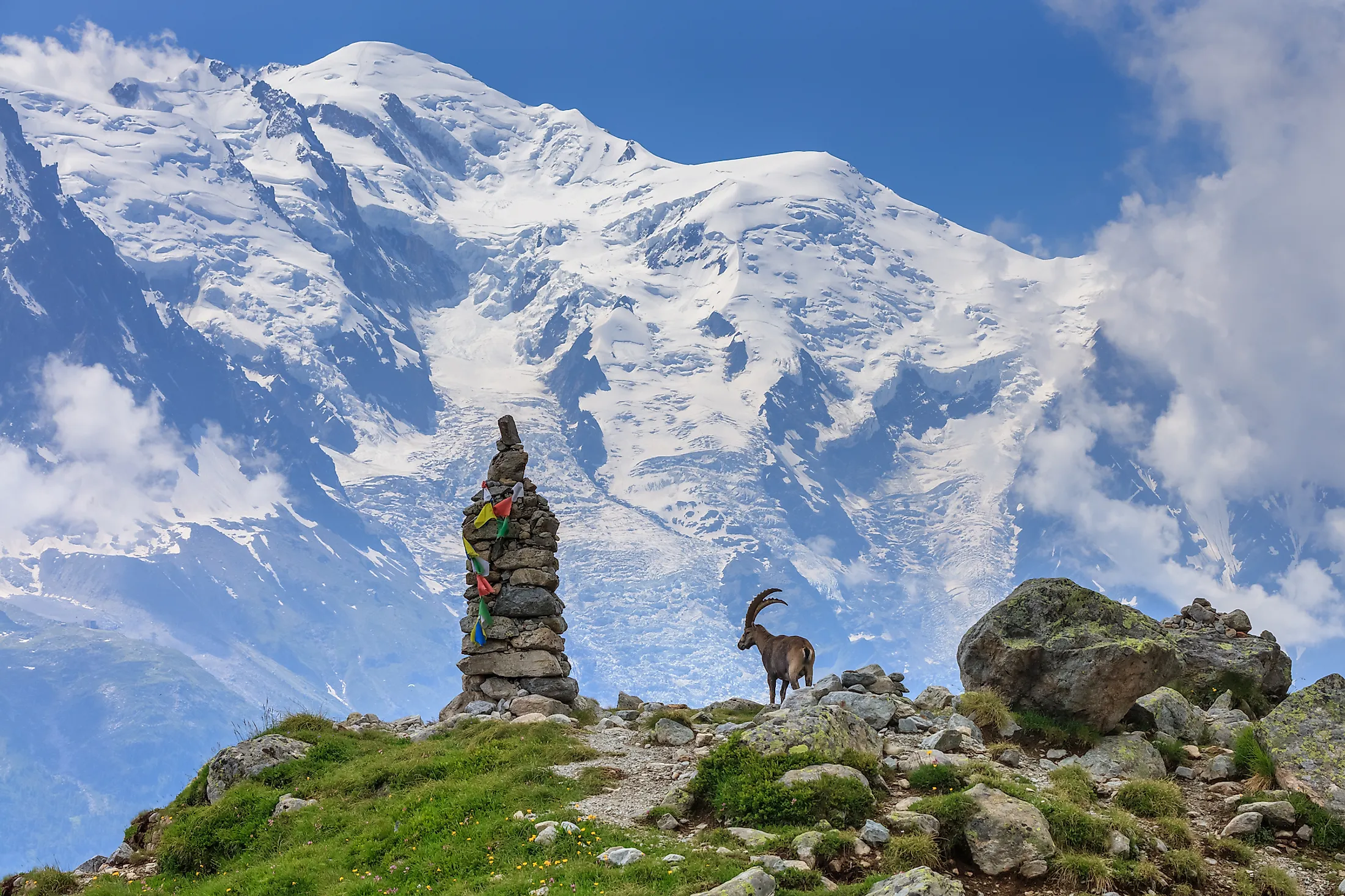
Mont Blanc
Mont Blanc, French for “white mountain”, is the highest mountain in the Alps and Western Europe, reaching a staggering 4,808.7 m (15,777 ft) altitude above sea level. Mont Blanc is the second most renowned mountain after Mount Elbrus, and the eleventh most prominent mountain peak in the world.
Location
The series or cluster of mountains—termed massif—extends along the French—Italian border, reaching Switzerland. The massif is part of a larger range referred to as the Gaian Alps, south of the massif. The Chamonix Valley and Savoy Alps are located to the west of the massif, the Pennine Alps are situated to the northeast and the Valley of Courmayeur situated to the east. There are other principal peaks within the same massif such as Mont Blanc du Tacul, Mont Maudit, Aiguille de Geant Les Grandes Jorasses, Mont Dolent and Aiguille du Midi.
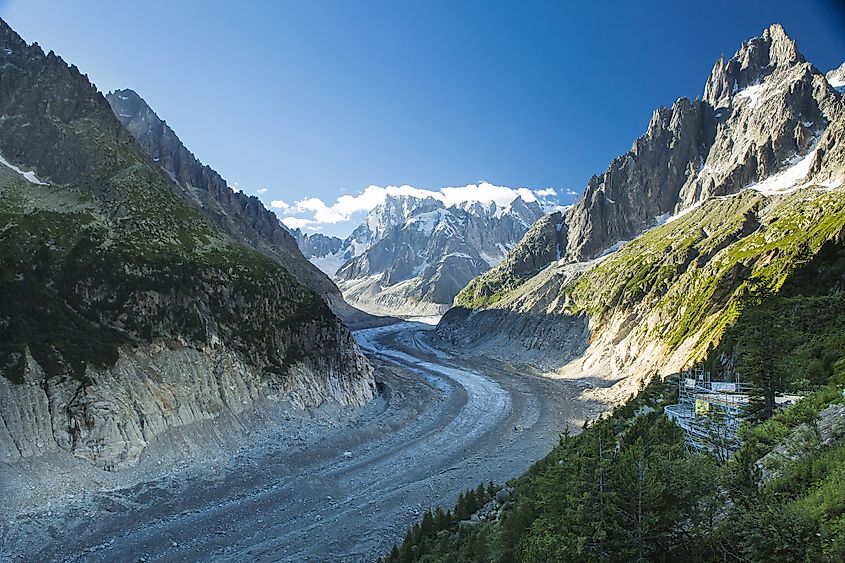
Due to the mountain’s remarkable altitude, a significant proportion is covered with glaciers, the most prominent being the Mer de Glace and the Miage Glacier, both being the longest glaciers in France and Italy, respectively. Jacques Balmat and Dr. Michel Paccard were the first to climb the Mont Blanc on August 8 1786. The first woman to reach the summit was Marie Parais in 1808. Today, Mont Blanc is a popular hotspot for hiking, climbing trail running and winter sports, with the Gouter Route being the most popular climbing route to the Mont Blanc summit. The three towns that surround the Mont Banc are Courmayeur in Aosta Valley, Italy and Saint-Gervais-les-Bains and Chamonix in Haute-Savoie, France.
Geography
The Mont Blanc summit is located on a watershed line between valleys of Ferret and Veny in Italy, and valleys of Montjoie and Arve in France, situated on the border between the two countries. Nevertheless, the ownership of the summit has been a subject of dispute between the two countries for a long time. The massif extends for 46 kilometers (29 miles) and lies in a southwest to northeastern direction across the borders of France, Italy and Switzerland. The massif’s northeastern end extends into Switzerland for about 40 km (25 miles) southwestward from Martigny, Switzerland.
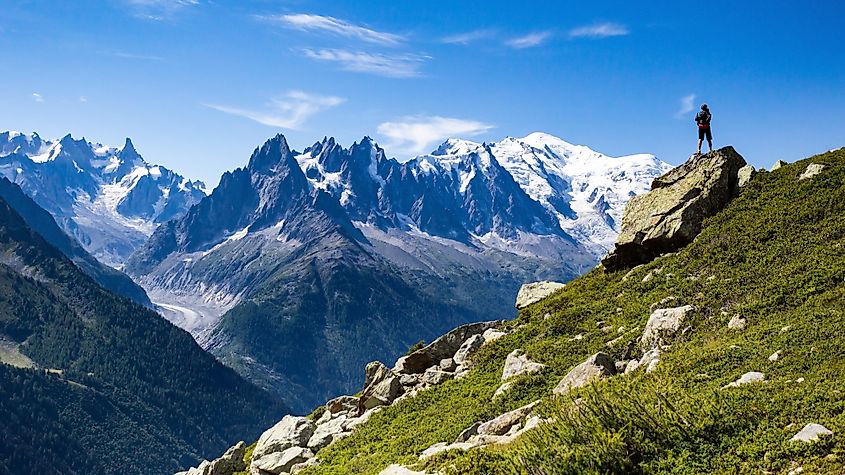
The northern side of the massif is mainly situated in France, bound by the valley of Arve containing the towns of Argentiere, Chamonix and Les Houches. Val Montjoie bounds the massif from the west while Val Veny and Val Ferret in Italy bound the massif from the south. Interestingly, the northeastern end of the massif in Switzerland is bound by a separate valley also called Val Ferret, which separates it from the Pennine Alps in the east.Due to its remarkable height, a significant section of the massif is covered with ice and deeply dissected by glaciers. Glaciers cover 170 square kilometers (66 square miles) of the massif whereby 110 km2 of which are situated in France. An ice cap covers the summit of Mont Blanc, and its thickness varies from year to year.
Geology
The geology of Mont Blanc is a product of the complex geology of the Alps. The Alps originated 770 million years ago when upheaval of the earth’s crust lifted up schist, gneiss and limestone rocks through the collision of the African and European tectonic plates. The Mont Blanc and the Aiguilles Rouges are predominantly made of granite intrusions and metamorphic rocks, which were originally responsible for the formation of the base of the mountains and have pushed through the older rocks around 300 million years ago. However, sedimentary rocks were then formed after the granite and metamorphic rocks were eroded away. Once again, the collision of continental plates caused the uplift of the earth’s crust which led to the formation of the Alps' great mountain ranges, 15 million years ago. This was followed by successive ice ages that caused the glaciers to advance, retreat and advance again. This movement across the landscape shaped the mountains and valleys today.
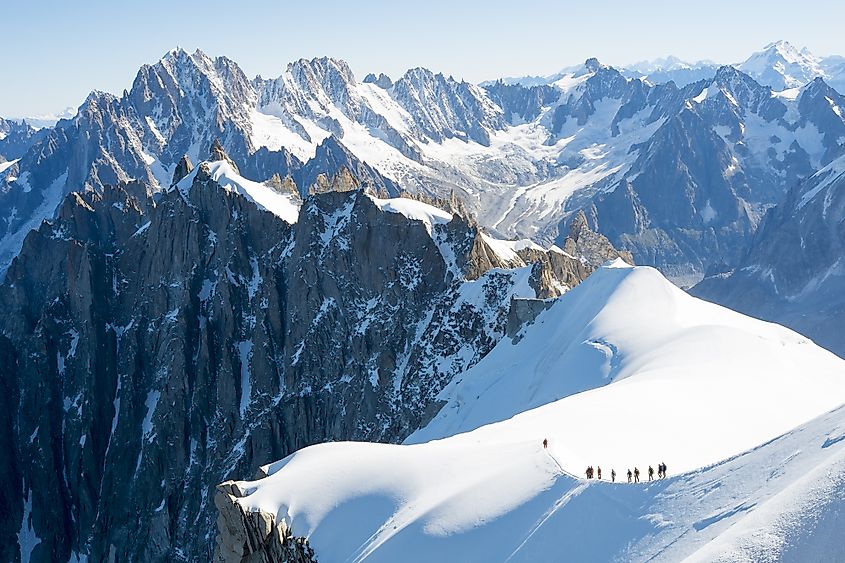
The Mont Blanc massif and Aiguilles rouges now form part of the external zone of the Alps, being the outermost layer of rock. Central granites make up the Mont Blanc, in addition to the steep slopes of the Drus, the Grandes Jorasses and the Dent du Geant. Schists are also visible near the Mont Blanc’s summit. Broad valleys, which formed along fault lines, define the massif which has been shaped by ice during the last glacial period of the ice age.
The granite of the Mont Blanc was an important source of stone for buildings during the mid-19th century. One hundred Italian stonemasons were brought to the Chamonix valley by Charles Albert of Sardinia to reconstruct the towns of Sallanches and Cluses that were damaged by fires.
Climate
The Mont Blanc massif is situated between two different climatic regions of the northern, western and southern Alps. The climate is greatly influenced by altitude, subsequently being cold and temperate. A significant proportion is permanently glaciated or snow-covered and is exposed to extremely cold weather conditions. Daytime valley temperatures in July and August may reach up to 25o Celsius (77o F) or even 30oC (86oF). The greatest amount of snowfall occurs between the months of November and April. The summit has a permanent ice cap, with temperatures around -20oC (-4oF), and is prone to strong winds. Precipitation is fairly distributed over the course of the year, and mostly originates from a westerly airflow. There is significant variation of precipitation with altitude, as precipitation is considerably less near the summit of Mont Blanc.
Flora And Fauna
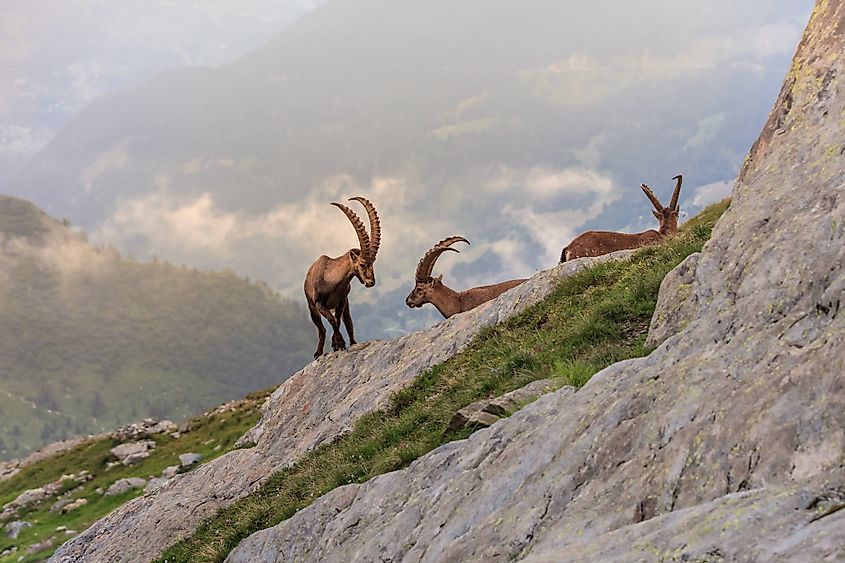
The height range, varying climate and different habitats in the valleys and summits have created a very rich biodiversity in the massif. The mountains around Mont Blanc are home to many mammal species, such as the Ibex, chamois, deer, mountain hare and alpine marmot. While there are no endemic species to the Mont Blanc, there are many rare (and legally protected) species found within its four major altitudinal habitat zones: montane forests, sub-alpine, alpine and nival zones. The major habitats are coniferous forests, moors, rock and talus slopes and glacial moraines.
Over a thousand plant species have been discovered across the massif, located on high altitudes reaching up to 3,800m (12,500 ft) and where the alpine chrysanthemum is found. In the middle of the Glacier de Talèfre, which is surrounded by ice and south of Les Droites, a large triangular region of steep mountainside contains an unusual mixture of high-alpine vegetation situated at a great altitude (2,650m and 3,000 m), giving the area the name Jardin de Talèfre. Some species include: Achillea nana; Alchemilla pentaphylla; Arenaria biflora; Arenaria serpyllifolia; Cardamine alpina; Draba frigida; Empetrum nigrum; Epilobium alpinum; Helictotrichon versicolor and many more.











